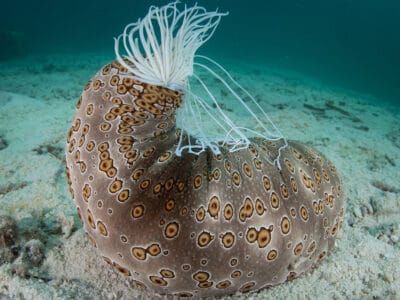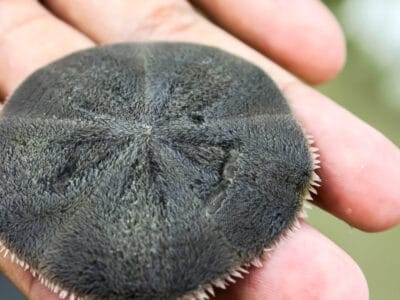Echinoderms are marine invertebrates from the Echinodermata phylum.
The word echinoderm derives from the ancient Greek words “ekhinos” meaning hedgehog, and “derma” meaning skin.
Echinoderms are a type of marine invertebrate that have radial symmetry and unique vascular systems. This includes invertebrates like starfish or sea stars. All echinoderms belong to the Echinodermata phylum. Their radial symmetry allows all parts of the body to match up when rotated up to 360 degrees.
A fair way to describe them is as spiny-skinned marine animals that do not have a brain. They are one of the oldest groups of animals on earth, with traces of existence since the Cambrian Period around 542 million to 485.4 million years ago. Around 13,000 species have gone extinct, and there are currently around 7,000 species.
Echinoderms Taxonomy and Scientific Classification
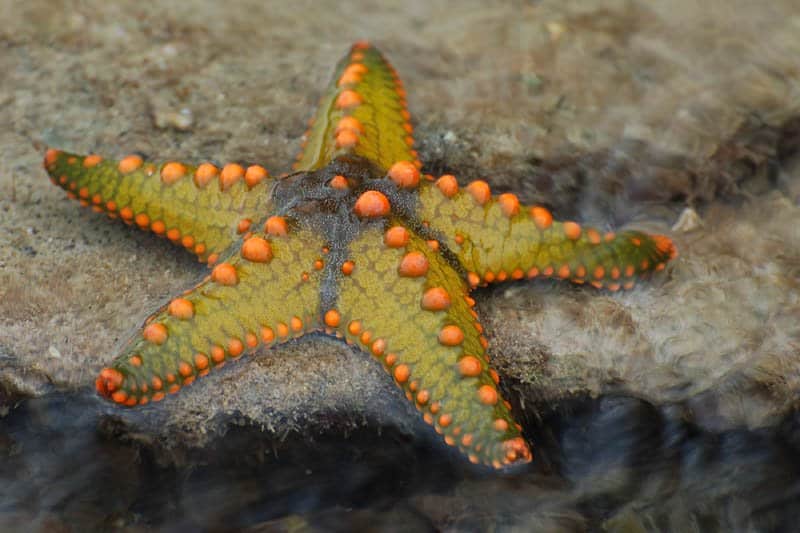
The starfish is just one example of an echinoderm.
Echinoderms belong to the Echinodermata phylum, which consists of thousands of species. They belong to the Echinus genus and are broken down into different subphyla and 21 different classes. All echinoderms are bilaterians that evolved from bilaterally similar animals. They are the second largest group of Deuterostomia. The extant subphyla of echinoderms are Crinozoa (Crinoidea), Asterozoa (Ophiuroidea, Asteroidea), and Echinozoa (Echinoidea, Holothuroidea). With the extinct subphyla consisting of the Blastozoa and Homalozoa.
- Kingdom: Animalia
- Subkingdom: Eumetazoa
- Superphylum: Deuterostomia
- Phylum: Echinodermata
Echinoderms Location and Habitat
Researchers believe the oldest fossils of echinoderms from the lower Cambrian Period to be asterozoa from the Ordovician Period, as well as crinoids from the Paleozoic Era. They rest along the ocean’s sea bed, ranging from the intertidal zone to the abyssal zone. The depth of an echinoderm’s habitat can be shallow, such as starfish in tidal pools, or it can be in extreme depths. The adults are primarily benthic and prefer to attach themselves along the seabed, whereas the larvae may live as plankton. Certain holothuroid adults and echinoderm larvae will inhabit the pelagic parts of the ocean. The two great groups, Pelmatozoa and Eleutherozoa, describe the echinoderm’s habitat rather than separating the phyla. Pelmatozoa would attach themselves to the sea bed, while Eleutherozoa would swim freely in the ocean.
List of Echinoderms
Crinoidea
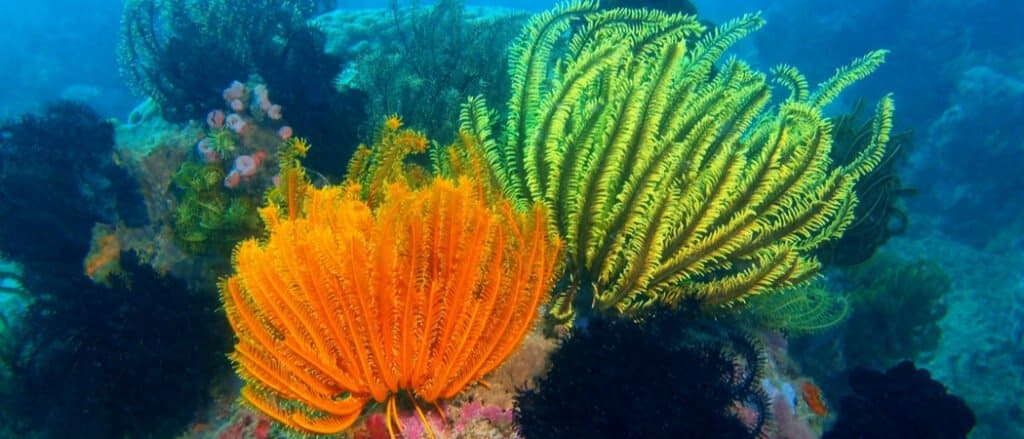
Sea lilies are part of the Crinoidea class, which itself is part of the Echinodermata phylum.
©Ogurtsov/Shutterstock.com
- Feather stars
- Sea lilies
Echinozoa

Red sea urchins live in the northeast Pacific Ocean, between Alaska and Baja California.
© NatureDiver/Shutterstock.com
- Sea cucumbers (Holothuroidea)
- Sea urchins, sand dollars, sea biscuits, heart urchins (Echinoidea)
Asterozoa
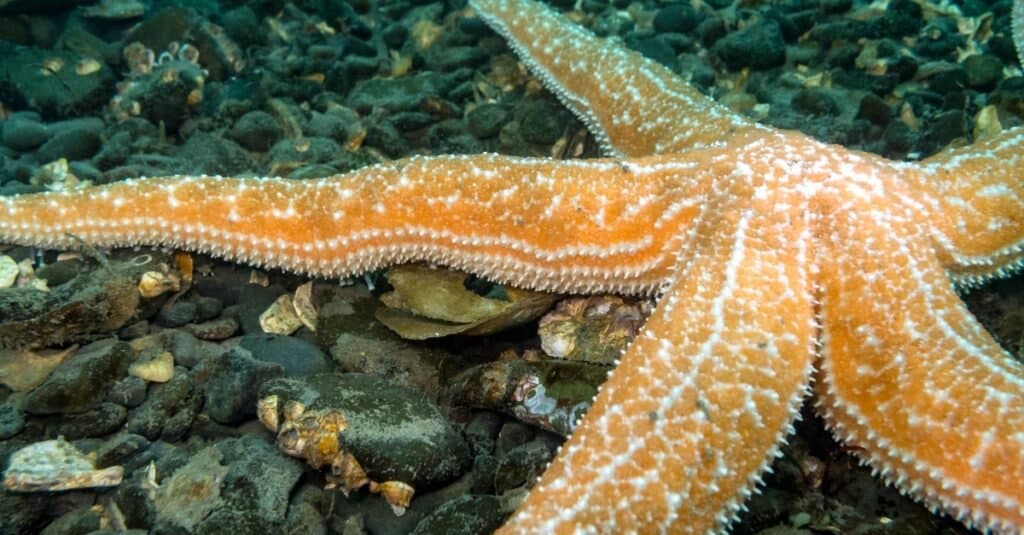
The scientific name for mottled stars is
Evasterias troschelii. They are starfish, and therefore, belong to the Echinodermata phylum.
©iStock.com/naturediver
- Brittle and basket stars (Ophiuroidea)
- Starfish (Asteroidea)
Echinoderm Characteristics and Functions
Anatomy
Echinoderms are triploblastic metazoans, meaning their bodies contain three germ layers – the endoderm, mesoderm, and ectoderm. They have a calcareous mesodermal skeleton that is made of ossicles. Ossicles are calcite plates that attach via catch connective tissues. These ossicles can either be fused or articulate depending on the type of movement required. Echinoderms may have spines, bumps, or granular formations on their ossicles, such as the spines of the sea urchin. All echinoderms have a coelomic cavity, water vascular system, digestive system, and central nervous system.
The body structure of an echinoderm is made up of calcium carbonate. While adults use radial symmetry, larvae use bilateral symmetry. That is a type of pentamerous radial symmetry that allows the animal to have five equal body parts. This is clear in starfish and sand stars, which have five distinct points in their bodies.
Water Vascular System
One of the characteristic features of an echinoderm is a water vascular system that is used for movement, sensory reception, respiration, or transporting food or waste in their bodies. This water vascular system is responsible for providing the pressure that controls their external tube feet. It consists of various channels from these tube feet that belong to the echinoderm coelomic cavity, which also holds the peri haemal, haemal, perivisceral, and gonadal coelom.
Their water vascular system contains their stone canal, ring canal, radial canal, and madreporite. Instead of relying on blood vessels, which they don’t have, they rely on the water vascular system to transport nutrients and gases throughout their bodies.
Digestive System
Their digestive system is quite simple, and it contains a mouth and anal region, intestines, rectum, esophagus, and a two-part stomach. They can be carnivores, such as starfish, and the majority of echinoderms are filter or substrate feeders. In most echinoderms, the anus and mouth part are located on opposite sides of the animal’s body, with the exception of Crinoidea. They typically have a two-part stomach, consisting of the upper stomach (pyloric) and the lower stomach (cardiac). The digestive glands produce an enzyme that allows their food to be digested.
Central Nervous System
Even though these animals do not have a brain, they still have a central nervous system. In fact, they have a network of nerve plexuses, which are located beneath the surface of an their body. As a result, echinoderms such as starfish are capable of feeling pain because of their complex nervous systems.
Locomotion
The external tube feet, spines, and complex water vascular system in echinoderms allow for locomotion. The ampulla near these tube feet helps to push water into the feet and forces water in to create a suction effect. The sea urchin is an example of one that can move on its spines.
Most echinoderms move very slowly, and certain species can control their rigidity by their catch connective tissue. This is a collagen-based tissue that enables echinoderms such as starfish to remain rigid to prevent being removed from rocks or crevices by nervous control. Echinoderms are capable of movement along surfaces or floating in the water as an adult.
Regeneration
An interesting feature noted in some echinoderms is their ability to regenerate lost limbs including internal organs. This can be seen in brittle stars or starfish who can regrow any arms that have been broken off. Certain species of echinoderm such as brittle stars use regeneration to reproduce. If the limb is broken off, specialized skin cells will cover and protect the wound. This allows the echinoderm to begin regrowing their limbs.
Reproduction
Echinoderms can reproduce asexually or sexually depending on the species. In asexual reproduction, the echinoderm may split into two and will develop into a new echinoderm known as fragmentation. With sexual reproduction, the echinoderms will release sperm and eggs into the water where the eggs are then fertilized. Echinoderms reproduce externally, and they do not need to make contact for successful fertilization. Most echinoderms will become sexually mature between 2 to 3 years of age and are born either male or female. The larval forms will then develop into an adult.
Pronunciation
Eh – keen-oh – derm















